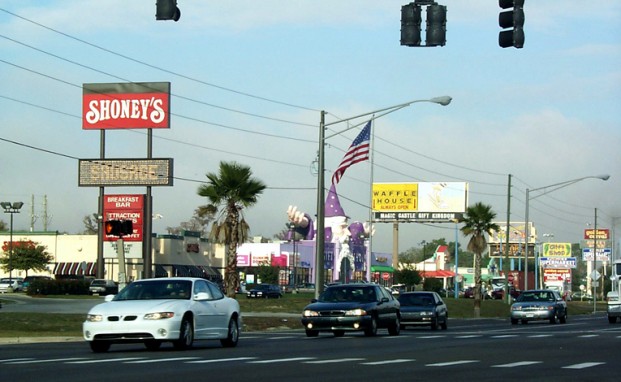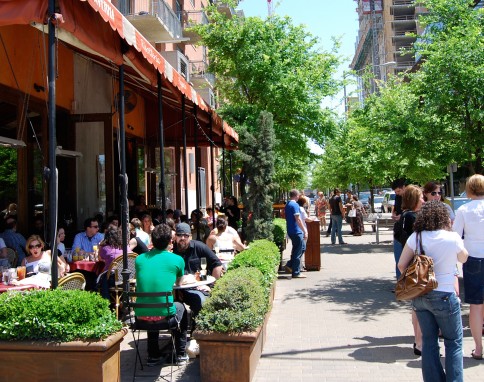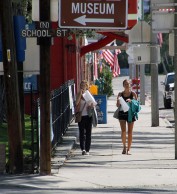Walkability is not a new idea. Some of the most world’s most beloved and most visited cities like Paris, Venice, and New York are inherently walkable—it’s no coincidence they were established long before the advent of the automobile. Vancouver, B.C., known for its public transportation, bike lanes, and green spaces, was incorporated April 6, 1886, the same day the Transcontinental Railroad arrived and the same year German inventor Karl Benz received a patent for the Benz Patent-Motorwagen, regarded as the first modern automobile.

The Federal Housing Administration, created as part of President Roosevelt’s New Deal, aimed to restructure the private house-financing system that had collapsed during the Great Depression. However, the design guidelines adopted by the FHA to qualify subdivisions for financing gave rise to the suburbs, creating massive communities of single-family homes situated away from busy streets and surrounded by archetypal green lawns, and led to the decline of walkability in America, according to H. Pike Oliver, of Cornell University’s College of Architecture, Art & Planning.
The automobile was supposed to bring freedom to American families. They would be able to live in sprawling communities, with their own plot of land, and with their car, still be able to access the amenities and services of the cities. In 1950, there were three cars for every 10 Americans; in 2000, that number grew to eight cars for every 10 Americans, leading to a dramatic shift in how America spends its money. Today, working families spend more on transportation than they do on housing—not to mention food and clothing. As car travel became more present in American life, people drove more—to work, to school, to the grocery store, and to virtually every other daily errand. Vehicle miles driven have increased by 60% since 1970, with only slight drops during recessions. In 2005, that trend began to change. A significant drop occurred during the most recent recession, but the fact that it has continued is encouraging.
“Physical inactivity is the biggest public health problem of the 21st century,” said Steven N. Blair, of the University of South Carolina’s Department of Exercise Science in an interview for the new documentary, The Walking Revolution. Two thirds of Americans are now overweight or obese—pair that with a dramatic increase in heart disease and diabetes. Experts believe inactivity that stems from the fact that there is no longer such thing as a useful walk is the root cause of the obesity epidemic. The only solution many say, is to restore walking to American culture.
A recent study by GfK Research for Kaiser Permanente reveals that in fact, most Americans—over 90%—already know walking is good for them, and admit they should walk more. The study also showed that community design and a lack of infrastructure inhibited walking as a lifestyle choice. Around 40% of respondents described their neighborhoods as “not very” or “not at all” walkable.
“The worst idea [America has] ever had is suburban sprawl,” said city planner Jeff Speck during a recent TED talk. “I believe that this American healthcare crisis we’ve all heard about is an urban design crisis, and that the design of our cities can be a cure.” He adds that car crashes are the single largest killer of healthy adults. “If your city is designed around cars, it’s really good at smashing them into each other.” But beyond the health concerns of a car-friendly lifestyle, Speck says there are economic and environmental arguments as well. Dense cities consume less gasoline and energy than less dense communities and stimulate economic growth.
Speck points to Portland as an urban design success story. He says that when other cities were getting in their cars and sprawling in all directions, Portland instituted an urban growth boundary and a skinny streets program to encourage biking and walking—the city spent 60 million dollars over thirty years on biking. Young educated millenials in search of a hip, walkable lifestyle are flocking to the city; Portland’s population of college-educated millenials is now five times greater than the national average. According to Speck, the best way for a city to boost economic growth is to become a place where people want to be, and more and more, that means walkability.

Though the evidence suggests that not only are there health, environmental, and economic reasons to promote walkable places, as well as growing demand, walkability is not yet the default for land development. Some cities aiming to create more viable, livable, and walkable communities are turning to Form-Based Codes, which emphasize physical form and how buildings should relate to each other and surrounding streets rather than land use. However, shifting away from the suburban regulations established in the forties and fifties is not always easy; several components of modern codes can be contentious, challenging our ability to create new walkable places. For example, parking requirements are a sore point in the track record of modern coding. Many codes still require new developments to provide large amounts of on-site parking, which not only promotes driving, but also takes up valuable land and drives up cost (pun intended). Additionally, parking requirements are often mandatory and vary wildly from place to place and land use to land use. Graphingparking.com pegs land use versus parking spaces required across the country.
“All too often for residential and some mixed-use situations, even after laying out the facts and a detailed parking plan for their future, many city councils and their staffs—and often the public—aren’t ready to drop their ineffective parking approach of today for the effective parking approach that they need,” says Tony Perez, Opticos Design’s Director of Form-Based Coding. “They see the logic but typically hesitate at making substantive not to mention drastic changes, despite the need. This has a lot to do with their concerns about the transition between their current system and the new system. If you can’t tell them exactly what will happen in year ‘X’, the tendency is to retreat to the current approach. If you asked how far we’ve been able to get communities to reduce residential parking requirements, I’d have to say some to little.”
It’s a major education issue, Perez says. On one hand, there is still a high proportion of people that expect more cars no matter how walkable the place. Their logic is that if a place is successful, more people will come from farther away. That is true, but with a higher number of walkable places, wouldn’t there be more options for those seeking walkable places?
“Often, unless these people see a detailed transition plan that tells exactly how the parking will work each year without a shortage that will cause problems, they think, ‘What could it hurt to just be safe with some more parking?’” Though, Perez adds, in most mixed-use areas and main street environments, Form-Based Codes have made great strides in lowering parking requirements because people equate cool, walking main streets with multiple people arriving in one car. That connection has yet to become as widespread for typical neighborhoods.

The good news is that walkability isn’t just for urban environments; walkable, mixed-use development can benefit small towns and rural communities, too. “In our coding work we’ve been privileged to work in a broad range of environments, from large major cities like Austin, Texas, to small historic rural settlements in Beaufort County, South Carolina,” said Opticos principal Stefan Pellegrini. “We feel that walkability is something all communities can reasonably aspire to, whether it’s a dense, mixed-use downtown neighborhood, or simply finding ways to connect rural residents to a corner store or community center via a safe and easy walk.”
A small amount of walking every day can improve health, save money, and save the environment—and it’s fun. Some communities have started “walking school busses” as a way to get integrate physical activity into their children’s lifestyle. The idea is similar to a carpool, without the car. Volunteers circulate on regular routes escorting groups of children to school.
Enrique Peñalosa, former mayor of Bogotá, Colombia, said, “God made us walking animals, pedestrians. As a fish needs to swim, a bird to fly, a deer to run, we need to walk, not in order to survive, but to be happy.” Despite the challenges, little by little, from city blocks to small towns, walkability is sneaking its way back into the American lifestyle.